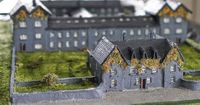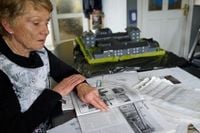In the quiet town of Tuam, Ireland, a haunting discovery from the 1970s has finally come to light, shaking the nation and prompting a reckoning with a painful past. What began as a chance encounter by two boys searching for stolen apples—a mass unmarked grave of infants and young children buried in a defunct septic tank on the grounds of the former Bon Secours Mother and Baby Home—has led to a groundbreaking excavation and a profound examination of Ireland’s history.
Franny Hopkins and Barry Sweeney, the boys who stumbled upon the grim secret, recalled the unsettling sound of their footsteps hitting the ground beneath a concrete slab they pried open. Hopkins described it as “just a jumble of bones,” unsure if they had uncovered a treasure or a nightmare. It would take decades and the determined work of local historian Catherine Corless to unravel the full horror of what lay beneath.
Mother and baby homes like the one in Tuam were established across Ireland in the 1920s, following the country’s independence from Britain. Primarily run by Catholic nuns, these institutions were meant to house unmarried mothers and their children—groups ostracized by society and burdened by stigma. The Tuam home itself opened in 1925 in a repurposed 1840s workhouse, a building already steeped in sorrow, having been used as a military barracks and site of executions during the Irish Civil War.
The conditions at the home were harsh and unforgiving. Primitive buildings with poor heating and limited running water housed over 200 children and 100 mothers at a time. Women were often confined there for up to a year, separated from their children, many of whom were left to suffer in overcrowded dormitories. A 1947 inspection report paints a grim picture: twelve of 31 infants were emaciated, with others described as “delicate,” “wasted,” or having “wizened limbs.”
Among those affected was Anna Corrigan’s family. Raised as an only child, Corrigan later discovered through painful research that her mother had given birth to two sons in the Tuam home, both of whom died in infancy. John Dolan, born weighing nearly nine pounds, succumbed to a measles outbreak two months after birth. Her other brother, William, died about eight months after his birth in 1950, though no death certificate exists, and his birth date was altered—likely to mask adoption records. Corrigan’s story is one of many that reveal the immense human cost hidden within the walls of these homes.
Tragically, the Tuam home recorded the highest infant mortality rate among 18 such institutions across Ireland, with nearly a third of children dying before the home’s closure in 1961. A government commission later revealed that approximately 9,000 babies—about 15%—died in mother and baby homes during the 20th century, with some years in the 1930s and 1940s seeing mortality rates exceeding 40% before a child’s first birthday.
Catherine Corless’s research unearthed the chilling fact that the mass grave was located in a disused septic tank, cleverly concealed behind the home’s towering walls. She published her findings in 2012, initially receiving little response. However, after journalist Alison O’Reilly’s 2014 front-page article in the Irish Mail headlined “A Mass Grave of 800 Babies,” international attention surged. Corless compiled a list of 796 deaths, sparking outrage and calls for accountability.
The Bon Secours Sisters, who ran the home, initially denied the existence of a mass grave, with a public relations consultant dismissing the claims as sensationalism and suggesting the bones might be from famine victims. Yet, a 2017 test excavation confirmed the presence of infant skeletons in the septic tank, prompting then-Prime Minister Enda Kenny to label the site a “chamber of horrors.” Pope Francis, during his 2018 visit to Ireland, issued an apology for the church’s “crimes,” including the forced separation of unmarried mothers and their children. The nuns also expressed profound remorse, admitting they failed to uphold the compassion and dignity owed to the women and children.
The state’s 2021 investigation largely attributed blame to the children’s fathers and the families of the mothers, though it acknowledged the role of institutions in providing a refuge when families rejected these women. The report sparked mixed reactions: some survivors felt vindicated, while others criticized it as a whitewash. Prime Minister Micheál Martin apologized on behalf of the nation, stating, “The shame was not theirs — it was ours.”
Now, in July 2025, a team of forensic scientists and archaeologists has begun a painstaking two-year excavation of the site. Led by Daniel MacSweeney, who has experience identifying missing persons in conflict zones, the project aims to recover, sort, and identify the remains using DNA technology. Nearly 100 individuals from countries including the U.S., Britain, Australia, and Canada have provided DNA samples or expressed interest in doing so, hoping to reconnect with lost relatives.
The excavation has stirred complex emotions in Tuam. Some residents, like Patrick McDonagh, believe the site should remain undisturbed, pointing to religious blessings and ongoing Masses held there. Yet survivors and families of the deceased see the dig as a chance for long-overdue justice and dignity. Anna Corrigan reflects on the significance: “They were denied dignity in life, and they were denied dignity and respect in death. So we’re hoping that today maybe will be the start of hearing them because I think they’ve been crying for an awful long time to be heard.”
Stories like that of Peter Mulryan, who lived in the home until age 4½, reveal the harsh realities faced by many. Mulryan endured abuse as a foster child, often shoeless and underfed, with scant education and little affection. He calls the church and state’s actions a “disgrace” and laments the unchecked power that allowed such suffering.
Other survivors, like Annette McKay, carry personal scars. McKay’s mother, Margaret “Maggie” O’Connor, was sent to the home after being raped as a teenager. Six months after giving birth in 1942, she was told her child had died and never spoke of it again. McKay later discovered her long-lost sister’s name among the deceased. Barbara Buckley, born in the home in 1957 and adopted at 19 months, recalls meeting her birth mother decades later, only to be told, “I don’t want anyone finding out about this.” The stigma of those times still echoes.
Meanwhile, Pete Cochran considers himself fortunate. Adopted by a family in the U.S. at 16 months, he escaped the harsh judgment faced by illegitimate children in Ireland. Yet even he recalls the hostility he once faced in Tuam, where locals were taught to scorn children like him. Cochran hopes the excavation reveals fewer remains than expected, wishing that many children were adopted and led good lives.
As the excavation unfolds, the world watches a small Irish town confront a dark chapter in its history. The bones beneath the playground and garden may finally give voice to nearly 800 lost children, offering a measure of closure and the dignity they were denied for so long.


